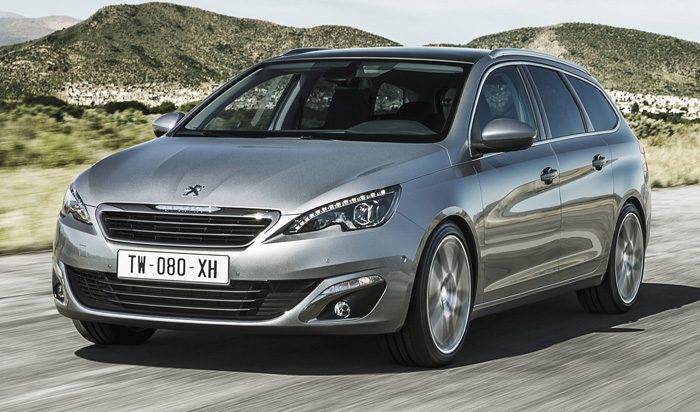
Short test: Peugeot 308 1.2 e-THP 130 Allure
To refresh the experience, we once again tested the model with the new 1,2-liter three-cylinder petrol engine. Blower and direct injection as accessories are already well developed in the automotive engine industry, but not yet in gasoline engines. This engine was mass-produced by PSA with the Citroën, DS and Peugeot brands a year ago and is gradually expanding into their offer. At the moment, there are two versions available, which differ only in power. Power options are available: 110 and 130 horsepower. The smaller one is yet to be tested, and the more powerful this time passed the test in slightly different conditions than our first 308 with the same engine. Now it was equipped with winter tires.
As a result, it turned out that the result of measuring consumption on the test also changed slightly. Not by much, but cooler air temperatures and winter tires added an average of 0,3 to 0,5 liters more fuel consumption - in both measurements, in the Avto store test cycle and in the entire test. The good side of the Peugeot turbocharger is that maximum torque is available at just over 1.500rpm and it pulls well up to high revs. With moderate driving and low speed, the engine performs much better and we can get close to the brand with only about five liters, which increases at higher speeds.
It looks like Peugeot has opted for higher gear ratios so it isn't as fuel efficient anymore - to do a better job of evaluating performance. The Allure trim is a label for Peugeot's rather rich equipment, and extra equipment was optional. Adding to the comfort experience are accessories such as tinted rear windows, lumbar adjustment for the driver's seat, navigation device, improved speakers (Denon), City park device with blind spot monitoring accessory and camera, dynamic cruise control, alarm, sports package with unlocking and keyless start, metallic paint and Alcantara upholstery.
And one more thing: 308 winter tires work better for a more comfortable ride. Which of the supplements you really need will probably have to be judged by everyone. If the buyer is satisfied with only the standard Allure equipment, which is actually quite rich, this can be seen from a smaller bill - a little more than six thousand euros. In this case, 308 is already a good buy! The undersigned adds that, unlike some, he is not bothered by the fit and size of the steering wheel in the Peugeot 308.
word: Tomaž Porekar
308 1.2 e-THP 130 Allure (2015)
Basic data
| Sales: | Peugeot Slovenia doo |
|---|---|
| Base model price: | 14.990 € |
| Test model cost: | 25.685 € |
| Power: | 96kW (130 KM) |
| Acceleration (0-100 km / h): | 9,6 with |
| Maximum speed: | 201 km / h |
| Mixed flow ECE: | 4,6l / 100km |
Costs (per year)
Technical information
| engine: | 3-cylinder - 4-stroke - in-line - turbocharged petrol - displacement 1.199 cm3 - maximum power 96 kW (130 hp) at 5.500 rpm - maximum torque 230 Nm at 1.750 rpm. |
|---|---|
| Energy transfer: | front wheel drive engine - 6-speed manual transmission - tires 225/40 R 18 V (Fulda Kristall Control HP). |
| Capacity: | 201 km/h top speed - 0-100 km/h acceleration in 9,6 s - fuel consumption (ECE) 5,8/3,9/4,6 l/100 km, CO2 emissions 107 g/km. |
| Mass: | empty vehicle 1.190 kg - permissible gross weight 1.750 kg. |
| External dimensions: | length 4.253 mm – width 1.804 mm – height 1.457 mm – wheelbase 2.620 mm – trunk 420–1.300 53 l – fuel tank XNUMX l. |
Our measurements
| T = 8 ° C / p = 1.061 mbar / rel. vl. = 62% / odometer status: 9.250 km | |
| Acceleration 0-100km: | 10,0s |
|---|---|
| 402m from the city: | 17,3 years ( 132 km / h) |
| Flexibility 50-90km / h: | 8,9 / 13,1s (IV/V) |
| Flexibility 80-120km / h: | 12,1 / 14,3s (Sun./Fri.) |
| Maximum speed: | 201km / h (WE.) |
| test consumption: | 8,1 l / 100km |
| Fuel consumption according to the standard scheme: | 6,1 l / 100km |
| Braking distance at 100 km / h: | 44,9m |
| AM table: | 40m |
evaluation
If you choose the right equipment, the Peugeot 308 can be a good choice, also because of its engine and usability.
We praise and reproach
driving position
roominess for the driver and front passenger
handling and position on the road
powerful enough engine
chassis behavior on short bumps
non-intuitive selectors in touch control
poor illumination of control buttons on the center screen and on the steering wheel
back bench seat